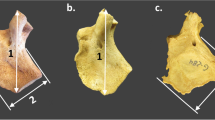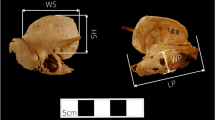Abstract
In the context of physical and forensic anthropology, when a child’s skeleton is damaged or in poor condition, which is common, many of the metric methods for the estimation of skeletal age cannot be used. In these circumstances, those more resistant bones, such as the pars basilaris, will be most useful. The aims of this study were to test existing methods for estimating skeletal age from the metric study of the pars basilaris and to propose new regression formulae. One hundred fourteen individuals aged between 5 months of gestation and 6 years were analyzed; seven measures were taken from each pars basilaris using a digital caliper. The chronological age was compared with the estimated age using the methods published by Fazekas and Kósa in 1978 and by Scheuer and MacLaughlin in 1994. New regression formulae are proposed, obtained by classical calibration, which include confidence intervals at 50 and 97.5 % to express the error. With both methods, significant differences were observed; the method of Fazekas and Kósa shows a tendency to underestimate the age, and the method of Scheuer and MacLaughlin tends to overestimate it. The proposed formulae represent a good tool for estimating age in many different contexts because they are relatively easy to apply, although other analysis systems, such as Bayesian approach or geometric morphometry, offer more robust and effective results.



Similar content being viewed by others
Bibliography
AlQahtani HM (2010) Brief communication: the London atlas of human tooth development and eruption. Am J Phys Anthropol 142:481–490
Irurita J, Aleman I, Viciano J, De Luca S, Botella MC (2014) Evaluation of the maximum length of deciduous teeth for estimation of the age of infants and young children: proposal of new regression formulae. Int J Legal Med 128:345–352
Cardoso HFV, Abrantes J, Humphrey LT (2014) Age estimation of immature human skeletal remains from the diaphyseal length of the long bones in the postnatal period. Int J Legal Med 128(5):809–824
Lewis ME (2007) The bioarchaeology of children. Cambridge University Press, Cambridge
Johnston FE, Zimmerman L (1989) Assessment of growth and age in the immature skeleton. In K. K. Iscan MY, Reconstruction of life from the skeleton. New York: Wiley-Liss. pp.11-22
Nagaoka T, Kawakubo Y (2015) Using the petrous part of the temporal bone to estimate fetal age at death. Forensic Sci Int 248: 188.e1-188.e7
Fazekas IG, Kósa F (1978) Forensic fetal osteology. Akadémiai Kiadó, Budapest
Scheuer L, MacLaughlin-Black S (1994) Age estimation from the pars basilaris of the fetal and juvenile occipital bone. Int J Osteoarchaeol 4:377–380
Schaefer M, Black S, Scheuer L (2009) Juvenile osteology, A laboratory and field manual. Elsevier, San Diego
Molleson T, Cox M, Waldron AH, Whittaker DH (1993) The Spitalfields Project volume 2—the anthropology, the middling sort. Council for British Archaeology, London
Cardoso HFV (2013) Age estimation of immature human skeletal remains using the post-natal development of the occipital bone. Int J Legal Med 127(5):997–1004
Madeline LA, Elster AD (1995) Suture closure in the human chondrocranium: CT assessment. Radiology 196:747–756
Tocheri MW, Molto JE (2002) Aging fetal and juvenile skeletons from Roman Period Egypt using basiocciput osteometrics. Int J Osteoarchaeol 12(5):356–363
Rösing FW, Graw M, Marré B, Ritz-Timme S, Rothschild MA, Rötzscher K, Schmeling A, Schröder I, Geserick GA (2007) Recommendations for the forensic diagnosis of sex and age from skeletons. HOMO 58:75–89
Cunha E, Baccino E, Martrille L, Ramsthaler F, Prieto J, Schuliar Y, Lynnerup N, Cattaneo C (2009) The problem of aging human remains and living individuals: a review. Forensic Sci int 193:1–13
Christensen AM, Crowder CM (2009) Evidentiary standards for forensic anthropology. J Forensic Sci 54:6
Olze A, Reisinger W, Geserick G, Schmeling A (2006) Age estimation of unaccompained minors. Part II: dental aspect. Forensic Sci Int 159:65–67
Schmeling A, Reisinger W, Geserick G, Olze A (2006) Age estimation of unaccompanied minors. Part I. General considerations. Forensic Sci int 159S:S61–S64
Dirkmaat DC, Cabo LL, Ousley SD, Symes SA (2008) New perspectives in forensic anthropology. Yearb Phys Anthropol 51:33–52
Liversidge H (2008) Dental age revised. In: Irish JD (ed) Techniques and application in dental anthropology. Cambridge University Press, Cambridge, pp 234–265
Schmeling A, Grundmann C, Fuhrmann A, Kaatsch HJ, Knell B, Ramsthaler F, Reisinger W, Riepert T, Ritz-Timme S, Rösing FW, Rötzscher K, Geserick G (2008) Criteria for age estimation in living individuals. Int J Legal Med 122:457–460
Ubelaker D (2008) Forensic anthropology: methods and diversity of applications. In: Katzenberg MA, Saunders SR (eds) Biological anthropology of the human skeletons. Wiley-Liss, New Jersey, pp 41–71
Ferrante L, Cameriere R (2009) Statistical methods to assess the reliability of measurements in the procedures for forensic age estimation. Int J Legal Med 123:277–283
Franklin D (2010) Forensic age estimation in human skeletal remains: current concepts and future directions. Leg Med 12:1–7
Liversidge H (2010) Interpreting group differences using Demirjian’s dental maturity method. Forensic Sci Int 20:95–101
Liversidge H (2015) Controversies in age estimation from developing teeth. Ann Hum Biol 42(4):397–406
Liversidge L, Buckberry J, Márquez-Grant N (2015) Age estimation. Ann Hum Biol 42(4):299–301
Márquez-Grant N (2015) An overview of age estimation in forensic anthropology: perspectives and practical considerations. Ann Hum Biol 42(4):308–322
Aykroyd RG, Lucy D, Pollard AM, Solheim T (1997) Technical note: regression analysis in adult age estimation. Am J Phys Anthropol 104:259–265
Ferrante L, Skrami E, Gesuita R, Cameriere R (2015) Bayesian calibration for forensic age estimation. Stat Med 34(10):1779–1790
Konigsberg L, Frnkenberg SR (2013) Bayes in biological anthropology. Am J Phys Anthropol 57:153–184
Godde K, Hens SM (2015) Modeling senescence changes of the pubic symphysis in historic Italian populations: a comparison of the Rostock and forensic approaches to aging using transition analysis. Am J Phys Anthropol 156:466–473
Tangmose S, Thevissen P, Lynnerup N, Willems G, Boldsen J (2015) Age estimation in the living: transition analysis on developing third molars. Forensic Sci Int 257:512e1–512e7
Braga J, Treil J (2007) Estimation of pediatric skeletal age using geometric morphometrics and three-dimensional cranial size changes. Int J Legal Med 121(6):439–443
Webster M, Sheets HD (2010) A practical introduction to landmark-based geometric morphometrics. In Quantitative methods in paleobiology. Alroy J, Hunt G. Paleontological Society Papers. pp. 163-188.
Alemán I, Irurita J, Valencia A, Martínez A, López-Lázaro S, Viciano J (2012) The Granada osteological collection of identified infants and young children. Am J Phys Anthropol 149:606–610
Tanner JM, Whitehouse RH, Takaishi M (1966) Standards from birth to maturity for height, weight, height velocity, and weight velocity: British children, 1965 Part II*. Arch Dis Childh 41:613
McBride GB (2005) A proposal for strength-of-agreement criteria for Lin’s concordance correlation coefficient. National Institute of Water and Atmospheric Client Report: HAM2005–062, Hamilton, New Zealand
Carneiro C, Curate F, Cunha E (2016) A method for estimating gestational age of fetal remains based on long bone length. Int J Legal Med. DOI 10.1007/s00414-016-1393-5
Cameriere R, Pacifici A, Pacifici L, Polimeni A, Federici F, Cingolani M (2016) Age estimation in children by measurement of open apices in teeth with Bayesian calibration approach. Forensic Sci Int 258:50–54
Acknowledgments
The authors are grateful to D. Jose Antonio Muñoz, Managing Director; Maribel Martín, coordinator of services; and all the EMUCESA staff at the San Jose cemetery in Granada for their invaluable assistance; to the Magistrate Judge (Court of First Instance n° 5), responsible for the Registry Office of Granada; and to two anonymous reviewers for their insights and suggestions.
Author information
Authors and Affiliations
Corresponding author
Ethics declarations
Conflict of interest
The authors declare that they have no conflict of interests.
Rights and permissions
About this article
Cite this article
Irurita Olivares, J., Alemán Aguilera, I. Proposal of new regression formulae for the estimation of age in infant skeletal remains from the metric study of the pars basilaris. Int J Legal Med 131, 781–788 (2017). https://doi.org/10.1007/s00414-016-1478-1
Received:
Accepted:
Published:
Issue Date:
DOI: https://doi.org/10.1007/s00414-016-1478-1




